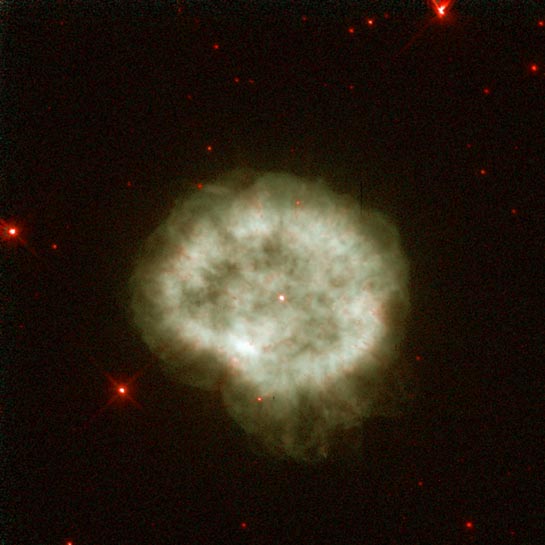
Planetary Nebula
RA 9h 21m 25.3s Dec -58° 18' 40.7"
Carina
6000 light years
9.5
15”
0.57 x 0.57 arcminutes
North is 34.5° right of vertical
Howard Bond (ST ScI) and NASA/ESA
December 17, 1997
ABOUT
THIS IMAGE:
This image is a part of the Hubble Gallery of Planetary Nebulae.
From Wikipedia:
NGC 2867 is a planetary nebula in the constellation Carina. It was discovered by John Herschel on April 1, 1834. (This was April Fools' Day, and ironically Herschel initially thought he might have found a new planet.)
From NASA:
Despite its eerie appearance, Caldwell 90 seems to be a fairly typical planetary nebula. It was discovered by John Herschel on April Fool’s Day in 1834 and later cataloged as NGC 2867. Ironically, he originally thought he may have discovered a new planet. More people than John Herschel have been fooled by the appearance of these nebulas, which is why the term “planetary nebula” was coined in the first place — they often look like planets when viewed with small telescopes.
Caldwell 90 was formed in the late stages of the evolution of a Sun-like star. After having steadily produced energy for several billion years through the nuclear fusion of hydrogen into helium in its core, the star underwent a series of energy crises when its supply of hydrogen began to run low. Without the outward force previously created by the energy production, gravity took over and caused the star’s core to contract. The extra pressure allowed the star to produce a heavier element — carbon — in its core. The synthesis of carbon generated a lot more energy than the fusion of hydrogen into helium, which helped the star to not only overcome gravity to expand once again but led the star to swell up a hundred-fold to become a red giant.
Eventually the red giant’s outer layers of gas were ejected. Meanwhile, the star transformed from a cool giant into a hot, dense star that radiates ultraviolet light and a fast wind of particles that move outward at around 6 million miles per hour. The stellar wind and ultraviolet light interact with the layers of gas that the red giant ejected to create the glowing, spherical shell we see today.
This Hubble image was taken in visible and infrared light using the Wide Field and Planetary Camera 2 as part of a survey of planetary nebulas. Caldwell 90 is located about 6,000 light-years away toward the southern constellation Carina and is best viewed in the late summer or early autumn from the Southern Hemisphere, though it can be spotted low in the sky during the late winter or early spring from Northern Hemisphere locations near the equator. It’s so tiny that it will look like a star even in fairly large telescopes, so use high magnification to get the best look. The magnitude 9.7 nebula will resemble a tiny turquoise stone embedded in the night sky.